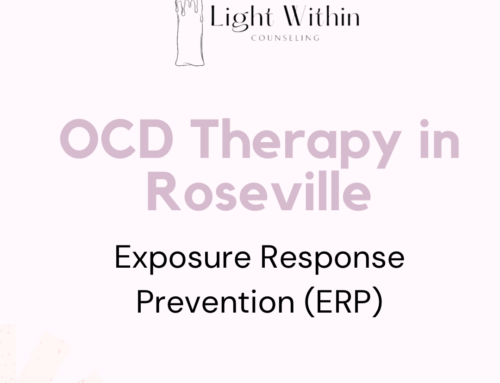How to Manage Excessive Worry and Rumination

We all experience moments where our minds get stuck on a troubling thought—perhaps replaying a conversation, worrying about something that could happen, or imagining worst-case scenarios. For some, these thoughts become so overwhelming that they feel like an endless cycle, akin to being trapped on a hamster wheel. This is what we call rumination or excessive worry, and it can be particularly challenging for those with Obsessive-Compulsive Disorder (OCD).
In this post, we’ll explore how Exposure and Response Prevention (ERP), a highly effective therapy for anxiety disorders and OCD, can help break the cycle of rumination and bring you back to a place of control. If you are dealing with excessive worry and rumination do not hesitate to reach out to start therapy in Roseville at Light Within Counseling.
What Are These Worrying Thoughts?
Imagine you’re concerned about something going wrong—whether it’s the safety of a loved one or the fear of making a mistake. You keep thinking about it, trying to figure out if it’s true or how to prevent it. But no matter how much you think, the worry keeps returning. This is rumination: when your mind fixates on a thought, making it feel impossible to stop, even though it causes anxiety.
For some, these thoughts become so frequent and intense that it feels like being trapped in a hamster wheel. The more they try to figure things out, the faster the wheel spins, but it never stops. This constant worry is exhausting, especially when it feels like you’re getting nowhere.
How Rumination Might Indicate Pure O OCD
In Pure Obsessional OCD (Pure O), the mind fixates on intrusive thoughts that trigger anxiety. Unlike other forms of OCD, where compulsions are visible (such as washing or checking), Pure O involves mental compulsions—like mentally checking, reassurance-seeking, or trying to “solve” the distressing thought. These rituals only feed the obsessional cycle, rather than providing relief.
These mental rituals might include mentally checking, such as replaying a conversation in your head to find out if you said the “wrong” thing, reassurance-seeking, like asking someone for confirmation that you’re not in danger, or trying to “solve” the thought, such as repeatedly analyzing a situation to determine the “right” answer or outcome. These mental compulsions may provide temporary relief, but they ultimately reinforce the obsessive cycle and increase anxiety in the long run.
Here’s how rumination could indicate Pure O:
- Endless Loop:
In Pure O, the thoughts seem to loop without end. No matter how much someone tries to analyze or solve the worry, the thoughts persist and grow stronger, much like being trapped in a hamster wheel where the mind spins but doesn’t move forward. - Mental Rituals:
To alleviate the anxiety caused by these thoughts, a person might engage in mental rituals—such as reassuring themselves, analyzing the thought, or running through the scenario over and over in search of the “right” answer. These attempts to “solve” the worry often increase the anxiety instead of reducing it, reinforcing the cycle. - Anxiety and Exhaustion:
The constant ruminating and need for reassurance can cause significant emotional distress. The individual feels driven to make sense of the thoughts or eliminate them, but the cycle never ends. This creates frustration and exhaustion, as peace of mind remains elusive. - Loss of Control:
The more someone tries to stop the ruminating thoughts, the less control they feel they have. This is a hallmark of Pure O—being trapped by one’s thoughts while chasing a resolution that feels just out of reach.
Why Rumination is Central to Pure O OCD
Rumination in Pure O isn’t just about worrying—it’s the mental compulsions that follow, such as trying to “solve” the worry by running through it repeatedly, seeking reassurance, or mentally checking. The more these rituals are engaged in, the more they feed into the cycle of obsessive thinking, leaving the individual feeling stuck and overwhelmed.
How ERP Helps:
1. Identifying the Thoughts
The first step in addressing excessive worry or Pure O (Purely Obsessional OCD) is to become aware of the specific thoughts that are causing the most distress. These intrusive thoughts often center around irrational fears, worst-case scenarios, or “what if” questions that feel overwhelming and unmanageable. By identifying and labeling these thoughts, you can begin to understand the patterns and triggers behind them, which is crucial for effective treatment.
Once these distressing thoughts are identified, your therapist can help you develop a fear hierarchy. This tool organizes your intrusive thoughts and fears into a list, ranking them from the least to the most anxiety-provoking. For example, if you struggle with intrusive fears about harming others, the hierarchy might include thoughts that range from mild discomfort (e.g., “What if I accidentally say something rude?”) to more intense fears (e.g., “What if I lose control and hurt someone?”).
Creating a fear hierarchy is a collaborative process between you and your therapist. Together, you’ll systematically explore each thought and rank it based on how much anxiety it produces. This process not only clarifies the scope of your worries but also provides a roadmap for tackling them.
2. Normalizing the Experience
It’s essential to understand that everyone experiences intrusive thoughts from time to time. The issue isn’t the thought itself, but how you respond to it. When we react with fear or distress, it can fuel the cycle of obsessive thinking. By recognizing that these thoughts are normal and don’t need to be feared or avoided, you begin to take the power away from them.
3. Exposure to the Thoughts (Mental Exposure)
In Exposure and Response Prevention (ERP), the goal is to confront distressing thoughts without engaging in compulsive mental rituals to neutralize them. This process, known as mental exposure, helps you break the cycle of anxiety and compulsions. Here’s how it works:
- Create a List of Triggers
Start by identifying the specific obsessional thoughts or scenarios that regularly cause you distress. These will form the foundation of your exposure work. - Practice the Thoughts
In a safe and controlled environment, deliberately bring these thoughts to mind. The aim is to allow the anxiety to rise and stay with the discomfort without attempting to neutralize, avoid, or suppress the thoughts. This practice teaches your brain that anxiety can subside on its own without compulsive behavior. - Start Small and Build Gradually
Begin with less distressing thoughts or situations and work your way up to more challenging ones. This gradual approach helps you build tolerance for anxiety at a manageable pace, increasing your confidence as you progress.
Exposure exercises are personalized and align with your hierarchy of fears, which ranks triggers from least to most distressing. For example, if your fear involves contamination, an initial exposure might involve writing out a scripted exposure of you touching a doorknob and resisting the urge to wash your hands. As you grow more comfortable, exposures may become more challenging, like actually touching the door knob in session without washing your hands or eating food prepared in a public setting without cleaning the area excessively.
These exercises are designed to help desensitize you to the thoughts and situations that trigger anxiety. Over time, they demonstrate that the feared outcomes are either unlikely to happen or manageable if they do. With consistent practice, ERP empowers you to reclaim control over your life and reduce the power of obsessive thoughts and compulsive behaviors.
4. Response Prevention: Stopping Mental Compulsions
The heart of ERP lies in response prevention—learning to resist engaging in mental compulsions such as seeking reassurance, trying to “prove” the thought right or wrong, or performing rituals to cancel it out. By resisting these behaviors, you allow yourself to experience the anxiety fully without reinforcing the cycle of fear and compulsion. Over time, you’ll discover that the anxiety naturally diminishes on its own, and the intrusive thoughts lose their power over you.
In addition to exposure work, your therapist may incorporate mindfulness and cognitive restructuring techniques. Mindfulness helps you observe intrusive thoughts without judgment, reducing the urge to react to them. Cognitive restructuring teaches you to challenge and reframe irrational beliefs, further diminishing the mental effort spent fighting or avoiding these thoughts.
By combining exposure with these therapeutic strategies, you can retrain your brain to respond to intrusive thoughts in healthier ways, breaking the cycle of worry and compulsion. While this step-by-step process can feel difficult at first, it is a vital step toward reclaiming your mental space and living free from the control of excessive worry or Pure O.
5. Embracing Uncertainty
OCD often comes with a strong need for certainty, the belief that if you don’t resolve the thought or find an answer, something bad will happen. ERP helps you accept that uncertainty is part of life. It encourages you to sit with the discomfort of not having all the answers. Over time, you’ll learn that you can manage without needing certainty, and that discomfort won’t last forever.
6. Cognitive Restructuring (When Appropriate)
While ERP focuses mainly on exposure and response prevention, some people may also benefit from cognitive restructuring. This involves recognizing when your thoughts are based on distorted thinking—such as believing that thinking about harm will cause harm or that not performing a mental ritual will result in catastrophe. Gently challenging these distorted beliefs can help reduce the emotional charge of the thoughts.
7. Celebrating Progress
ERP can be tough, especially when dealing with Pure O or excessive worry, but it’s important to celebrate every step forward. Whether it’s sitting with a difficult thought or resisting the urge to perform a mental ritual, each success is a win on the path to breaking the cycle of rumination and worry.
Breaking Free from the Hamster Wheel
Pure obsessional thoughts and excessive rumination can feel like a never-ending cycle, but with the right therapeutic approach, you can break free from the grip of these thoughts. Exposure and Response Prevention (ERP) provides a structured, evidence-based framework to help you confront your fears, tolerate distress, and regain control over your mind. By focusing on exposure, response prevention, and learning to accept uncertainty, ERP can help you manage your thoughts, reduce anxiety, and live a life no longer controlled by worry.
If you or someone you know struggles with Pure O or excessive worry, Light Within Counseling offers ERP therapy in Roseville, and this might be just the tool to help you move forward. Reach out to a therapist trained in ERP in Roseville to start your journey toward recovery. Light Within Counseling would be honored to be part of your journey towards freedom from constant anxiety.



